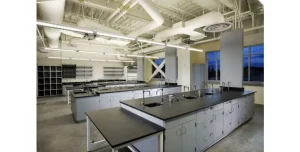Chemistry laboratories require specialized furniture that ensures safety, efficiency, and convenience for those conducting experiments. The design and material of this furniture are crucial for meeting the rigorous demands of chemical research and education.
Lab Benches and Workstations
Lab benches are central to any chemistry lab. They provide a stable and durable surface for conducting experiments. Typically made of chemical-resistant materials like epoxy resin or stainless steel, these benches resist corrosion, heat, and impact. The surface area varies, but a standard bench might measure approximately 150 cm in length and 75 cm in width, though custom sizes are available to fit specific lab layouts.
Island benches offer more workspace and are accessible from all sides, making them ideal for collaborative projects. They often include built-in sinks and gas fixtures for convenience.
Storage Cabinets
Chemical storage cabinets are essential for safely storing hazardous materials. They come in various types, including flammable storage, acid and corrosive storage, and general chemical storage. These cabinets are typically made of materials like steel coated with a chemical-resistant powder finish to prevent corrosion. The size and capacity can vary significantly, with some cabinets designed to store only a few liters of chemicals, while others can accommodate several hundred liters.
Safety cabinets with specific features like self-closing doors, adjustable shelves, and spill-containment sumps add an extra layer of safety.
Fume Hoods
Fume hoods are critical for extracting hazardous fumes and providing a safe breathing environment. The size and specifications depend on the type of experiments conducted. For instance, a standard fume hood might measure around 120 cm in width and be equipped with airflow monitors, sash height alarms, and fire-resistant materials. The airflow speed is typically adjustable, with a recommended face velocity of 0.3 to 0.5 meters per second.

Utility Services
Gas taps and sinks are common in chemistry labs. Gas taps provide controlled access to gases like natural gas or nitrogen, vital for various experiments. Sinks are typically made of materials resistant to chemicals and heat, like stainless steel or epoxy resin, and come in different sizes to accommodate glassware cleaning and waste disposal.
Seating
Lab chairs and stools are designed for comfort and durability. They are often adjustable and made of materials that are easy to clean and resistant to chemicals.
Specialized Equipment
Depending on the lab's focus, additional equipment like distillation racks, glove boxes, and drying racks might be necessary. These items are tailored to specific tasks and come in various sizes and materials.
Conclusion
The furniture in a chemistry lab plays a pivotal role in ensuring a safe and efficient environment for scientific exploration. Its design and material choices are critical for meeting the specific needs of different chemical experiments. By understanding these essentials, one can better appreciate the complexity and requirements of a well-equipped chemistry laboratory.
